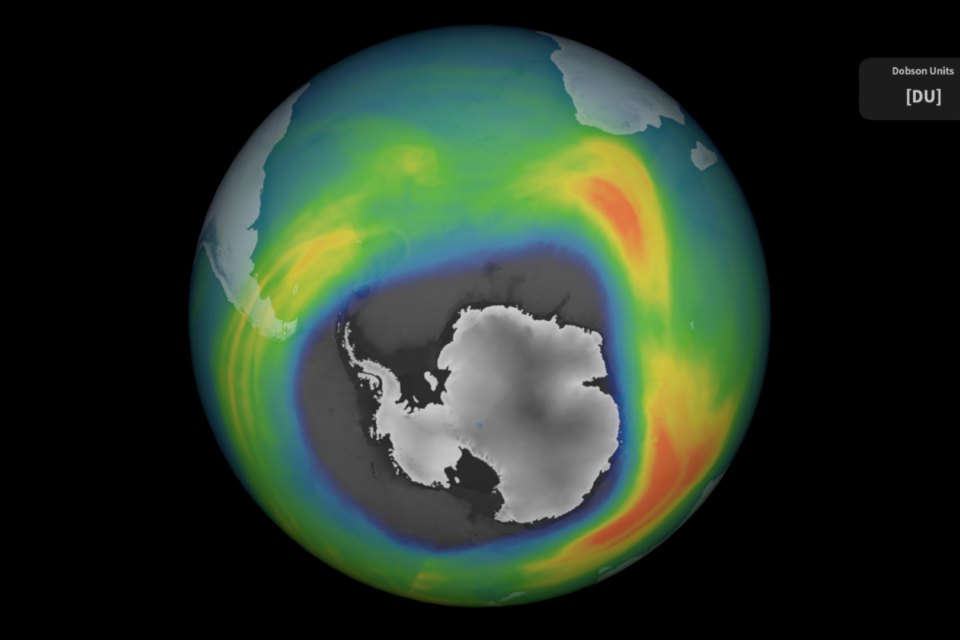Antarctica's ozone hole is now one of the largest on record

The recently measured ozone hole over Antarctica, as detected by the Copernicus Sentinel-5P satellite, is one of the largest on record, according to a report from the European Space Agency. The hole reached an astounding 26 million square kilometers on September 16, 2023 – approximately three times the size of Brazil.
The Sentinel-5P satellite was launched in October 2017 as the European Union’s first Copernicus satellite dedicated to atmospheric monitoring.
High resolution imaging
The satellite hosts a cutting-edge multispectral imaging spectrometer known as Tropomi. The instrument enhances atmospheric monitoring capabilities by identifying distinct “fingerprints” of various gases across different segments of the electromagnetic spectrum. This allows for more precise and higher resolution imaging of a wide array of pollutants.
The Tropomi’s data is meticulously processed at the German Aerospace Center (DLR) using algorithms co-developed by DLR and the Royal Belgium Institute for Space Aeronomy (BIRA-IASB).
Tropomi measurements
“The Sentinel-5P total ozone products have an accuracy at the percentage level compared with ground-based data and this allows us to closely monitor the ozone layer and its evolution,” said senior DLR scientist Diego Loyola.
“The Tropomi measurements are extending the global ozone data record of European satellite sensors covering almost three decades.”
The significant data from Sentinel-5P is provided to the Copernicus Atmosphere Monitoring Service (CAMS) within three hours post-measurement. This rapid delivery aids CAMS in efficiently incorporating the data into their analysis and forecasting systems.
One of the biggest holes on record
“Our operational ozone monitoring and forecasting service shows that the 2023 ozone hole got off to an early start and has grown rapidly since mid-August,” said Antje Inness, a senior scientist at CAMS.
“It reached a size of over 26 million sq km on 16 September making it one of the biggest ozone holes on record. Tropomi ozone data are an important dataset for our ozone analysis.”
Driving factors
Understanding the reasons behind the ozone hole’s substantial size is complex. Its size oscillation is closely related to the strength of strong wind bands circulating the Antarctic, a phenomenon resulting from Earth’s rotation and the temperature disparity between polar and temperate latitudes.
Strong wind bands act as barriers, trapping and cooling air masses over polar regions, thereby affecting the ozone hole’s size. The recent unusual ozone patterns might also be linked to the Hunga Tonga-Hunga Ha’apai volcano eruption in January 2022, which introduced substantial water vapor into the stratosphere.
Hunga Tonga eruption
“The eruption of the Hunga Tonga volcano in January 2022 injected a lot of water vapor into the stratosphere which only reached the south polar regions after the end of the 2022 ozone hole,” explained Antje.
“The water vapor could have led to the heightened formation of polar stratospheric clouds, where chlorofluorocarbons (CFCs) can react and accelerate ozone depletion. The presence of water vapor may also contribute to the cooling of the Antarctic stratosphere, further enhancing the formation of these polar stratospheric clods and resulting in a more robust polar vortex.”
However, understanding the exact impacts of this eruption on the ozone hole requires further research, as there are no precedents in modern observations for such substantial water vapor injections into the stratosphere.
Sentinel-5P monitoring is crucial
“The Sentinel-5P total ozone columns provide an accurate means to monitor ozone hole occurrences from space. Ozone hole phenomena cannot be used in a straightforward manner for monitoring global ozone changes as they are determined by the strength of regional wind fields that flow around polar areas,” said Claus Zehner, ESA’s mission manager for Copernicus Sentinel-5P.
Additionally, the presence of ozone-depleting substances, primarily chlorofluorocarbons (CFCs), in the atmosphere still poses a significant threat to the ozone layer. These substances were prevalent in the 1970s and 1980s in various products but have since been phased out following the 1987 Montreal Protocol.
Although a gradual recovery of the ozone layer is anticipated, with predictions suggesting a return to normal levels by around 2050, monitoring and analysis continue to be crucial.
With advanced tools like the Tropomi on the Sentinel-5P satellite, scientists can now observe atmospheric changes with unprecedented accuracy and resolution, contributing valuable data to ongoing global efforts to understand and protect the Earth’s atmosphere.
Image Credit: European Space Agency









